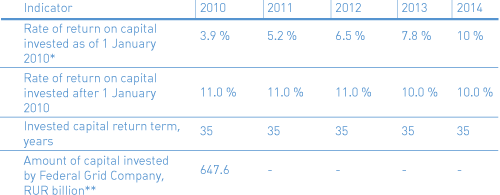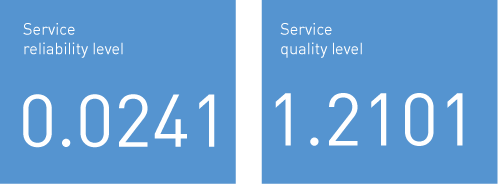Tariff Regulation
Energy transmission tariffs are subject to State regulation and are approved by the Russian Federal Tariff Service (FTS).
Key regulations governing tariff rates applicable to the UNEG energy transmission include:
— Federal Law No. 35-FZ on the Russian Energy Industry (dated 26 March 2003);
— Government Decree #1178 (dated 29 December 2011) on the pricing policy applicable to regulated prices (tariffs) in the energy industry;
— Government Decree #1220 (dated 31 December 2009) on defining applicable tariff rates on long-term tariffs for the reliability and quality of goods and services provided;
— Government Decree #1172 (dated 27 December 2010) on the approval of wholesale electricity and capacity market rules and amendments to some Government orders related to the wholesale electricity and capacity market;
— Russian FTS Decree #56-e/1 on the approval of methodological guidelines to calculate energy transmission tariffs via the Unified National (all-Russian) Electric Grid;
— Russian FTS Decree # 228-e (dated 30 March 2012) on the approval of methodological guidelines to regulate tariffs using the return on invested capital (RAB-regulation) method;
— Russian FTS Decree #347-e/4 (dated 4 December 2009) on the approval of the rate of return on invested capital to calculate tariffs on energy transmission tariffs via the Unified National (all-Russian) Electric Grid;
Before 2010, the UNEG energy transmission tariff rates for Federal Grid Company were established by the economically reasonable cost method.
Since 2010, as a part of measures to upgrade the investment attractiveness of the electricity industry, Federal Grid Company has had rates for electricity transmission services across the UNEG established based on the return on invested capital (RAB-regulation) method.
To determine the tariff for each year of the regulated accounting period, required gross proceeds are calculated by summing the values of the return, the return on invested capital and the value of expenditures required to render electricity transmission services across the UNEG. To avoid a sharp rise in rates as a result of the RAB-regulation, a smoothing mechanism is provided. This mechanism involves re-distributing required gross proceeds during the long-term regulatory period.
For the first long-term regulatory period (2010-2014), the Russian FTS established the following basic long-term tariff regulation parameters for Federal Grid Company based on the return on invested capital method.

** In connection with the adoption of the Russian Government Decree #1178 dated 29 December 2011 "On Price Setting in the Sphere of Regulated Prices (Tariffs) in the Electric Energy Industry", and the switch since 2012 to the recording of facilities on the basis of invested capital as they are commissioned, to calculate the required gross revenue for each year of the long-term regulation period, the actual cost of facilities put into operation in 2011, and the cost of facilities planned to be commissioned in 2012-2013 is reduced by the value of assets under construction, recorded in the cost of invested capital when Federal Grid Company switches to RAB-regulation in the amount of RUR205.6 billion, which is distributed for 3 years.
The Government of the Russian Federation decided to postpone the indexation of prices (tariffs) for goods (services) of natural monopolies, including electric grid companies from 1 January to 1 July of the next calendar year. Based on this, the Management of the Russian FTS made the decision to set Federal Grid Company’s tariffs for electric power transmission to the UNEG for H1 2012 at 2011 tariff levels.
In accordance with the Basics on Price Setting, Russian FTS Decree #113-e/1 (dated 21 May 2012) adjusted the rate of return on "old" capital, established for 2014: the rate of return on old capital in 2014 is set at the rate of return on "new capital" and is 10%.
For the North Caucasus Republics and the Stavropol Territory, the tariffs for electric power transmission and the maintenance of UNEG power facilities were set in the following amounts:
For 2010 – RUR37,845.23/MW per month;
For the period of 1 December – 31 March 2011 – RUR46, 029.88/MW per month;
For the period of 1 April 2011 – 30 June 2012 – RUR43,783.55/MW per month;
For the period of 1 July 2012 – 30 June 2013 – RUR48,540.01/MW per month;
Federal Grid Company Tariffs on Energy Transmission Services and UNEG Electric Facilities Maintenance for the 2008-2012 Period (RUR/MW/month)

Tariff regulation based on long-term tariff rates with a view to the return on invested capital involves the Company’s compliance with service reliability and quality performance as set forth by the Russian Federal Tariff Service (FTS). Order #296 of Russia’s Ministry of Energy (dated 29 June 2010) establishes methods to calculate the reliability and quality of provided goods and services for the organization operating the Unified National (all-Russian) Electric Grid (UNEG) and territorial grid organizations.
The performance list includes indicators of energy transmission reliability characteristics for technical failures and their effects on consumers and service quality provided to consumers which, in particular, describe the technical connection capacity.
The Russian FTS Order #254-e/1 (dated 26 October 2010) established methodological guidelines for the calculation and application of multiplying (decreasing) factors for compliance with tariff rates set for organizations that are involved in regulated activity (with the reliability and quality levels of provided goods and services). Subject to the above-mentioned Guidelines, the Company’s revenues will be subject to multiplying or decreasing factors within the 3% limit.
The FTS decision to establish 2011-2014 tariffs involves planned service reliability and quality indicators for the UNEG-operating organization for the 2011-2014 period.

In 2012, the actual reliability and quality levels of services provided by Federal Grid Company were:

The transition of Federal Grid Company to RAB-regulation ensured adequate financial potential to meet large-scale challenges in investment activities. The approved investment program will enable the Company to: enhance stable energy supply to customers, provide the generation capacity of power plants, upgrade its grid and implement a range of important government projects. Moreover, RAB-regulation defines a brand new approach to cost management in terms of established operational expense performance (2% per annum for Federal Grid Company).
